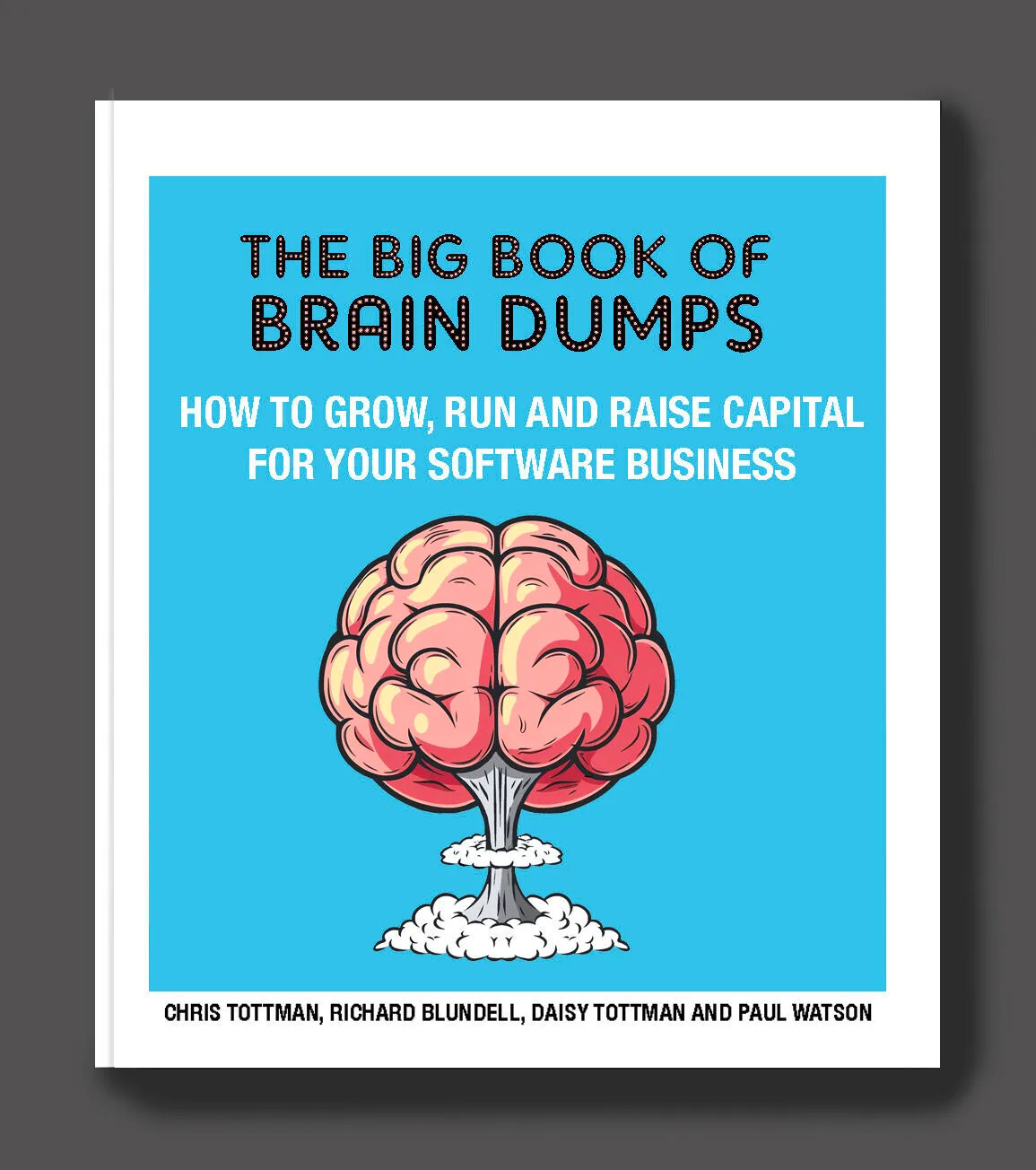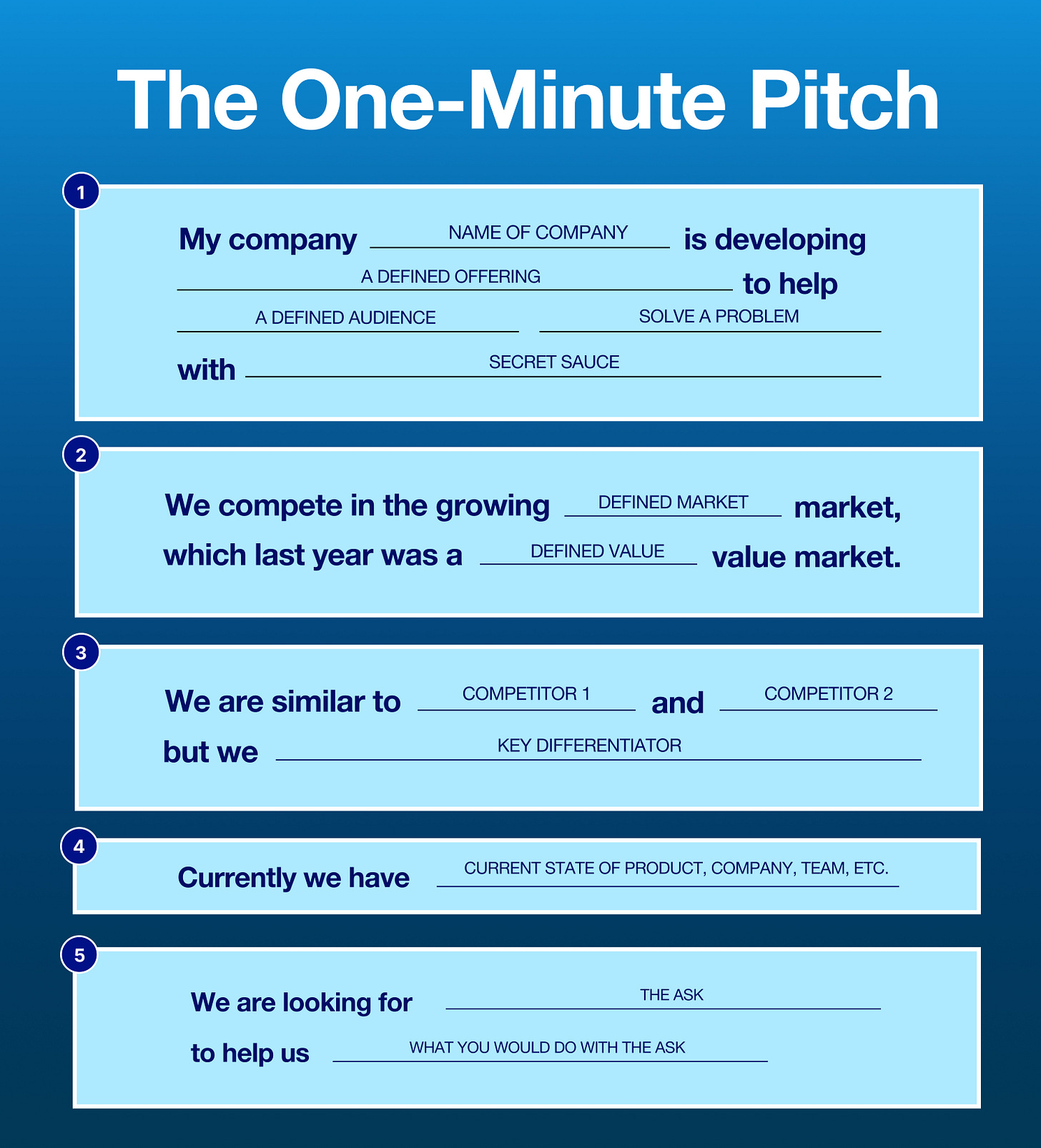🧠 Master the 60-Second Investor Pitch
The one-minute pitch formula that makes investors actually care.
👋 Hey, Chris here! Welcome to BrainDumps—a weekly series from The Founders Corner. If you’ve been reading along, you know this series is a preview of a bigger project. Well, it’s finally here: The Big Book of BrainDumps is out now!
It isn’t a theory book—it’s the founder’s field manual. Inside, you’ll find 70 powerful frameworks distilled from 30+ years scaling software companies to hundreds of millions in ARR, 20+ years investing in 500+ B2B tech startups, and over $1B of shareholder value created. From raising capital to hiring your first VP of Sales, this book turns scars and successes into practical playbooks you’ll return to again and again. I expect most copies will become well-worn, scribbled on, and dog-eared—because it works.
Table of Contents
Why Shorter Is Smarter (Especially Early On)
The One-Minute Pitch Framework
The 6-Part Formula
The Opener
The Market
The Competition
The Traction
The Ask
Pitching Beyond Investors
Common Pitfalls (and How to Avoid Them)
A Story from the Trenches
Final Thought: Know It Cold
I’ve lost count of how many pitch decks I’ve read over the years. Hundreds, maybe thousands. But I’ll tell you this: the ones that stick, the ones that grab you by the collar and make you pay attention, almost always have one thing in common.
They’re short.
Not short on substance—short on fluff. No jargon. No meandering intros. No 30-slide marathons trying to prove they’ve reinvented the wheel.
Just clear, confident storytelling that makes you sit up straight.
That’s why I love this visual so much: The One-Minute Pitch. It forces you to do the hard work up front. To get brutal with your messaging. To strip it all back until there’s nowhere left to hide. And that, for a founder, is gold dust.
Because here’s the truth: If you can’t explain your business in a minute, you probably don’t understand it well enough yet.
Why Shorter is Smarter (Especially Early On)
We’ve all been there. You’re at an event. You’ve got five minutes with someone who could change your life. An angel, a VC, a potential partner. They say, “So, what do you do?”
And you freeze.
Or worse—you waffle.
You start describing your product features instead of your customer problem. You name-drop TAM figures without context. You jump to your ask before they even know why they should care.
It’s painful. But it’s avoidable.
The earlier your stage, the simpler your pitch needs to be. That’s not a handicap—it’s a feature. In the early days, your edge is clarity. Clarity about who you’re helping, what pain you’re solving, and why you’re the one to do it.
And that’s exactly what the One-Minute Pitch gives you.
Let’s Break It Down: The 6-Part Formula
This cheat sheet from the Founder Institute isn’t just a nice visual—it’s a weapon. Use it. Fill it in. Rework it. Tape it to your desk.
Let’s go line by line.
1. The Opener
“My company [NAME] is developing [OFFERING] to help [AUDIENCE] solve [PROBLEM] with [SECRET SAUCE].”
This is your positioning, compressed.
You need to communicate what you do, who it’s for, and why you’re different—all in one sentence. Don’t be clever. Be clear.
Example:
My company, GreenGrid, is developing a carbon analytics dashboard to help mid-size manufacturers reduce emissions with AI-powered tracking and compliance tools.
See? We know who it’s for (mid-size manufacturers), what it does (carbon analytics dashboard), and why it’s special (AI-powered compliance).
2. The Market
“We compete in the growing [MARKET] market, which last year was a [VALUE] value market.”
This line adds weight. You’re placing your startup in a macro context.
Be specific. Use credible data. Show you’ve done the homework.
Example:
We compete in the growing sustainability analytics market, which last year was a $2.5B market and growing 18% YoY.
3. The Competition
“We are similar to [COMPETITOR 1] and [COMPETITOR 2] but we [DIFFERENTIATOR].”
This isn’t about slating the competition—it’s about showing you understand them and have a plan to beat them.
Pick relevant comps. Be honest about overlaps. Then draw your line in the sand.
Example:
We are similar to Watershed and Normative but we specialise in manufacturers with under 500 employees and offer integrations with legacy ERPs.
4. The Traction
“Currently we have [PRODUCT/TEAM/TRACTION STATUS].”
This is your proof. Show that you’re more than an idea. Even if it’s early, there’s always something to share.
Example:
Currently we have a working MVP, two pilot customers, and a founding team with deep manufacturing and climate backgrounds.
5. The Ask
“We are looking for [ASK] to help us [WHAT YOU’LL DO WITH IT].”
This is your close. Be specific. Don’t say “we’re raising.” Say what you’re raising, why, and what you’ll do.
Example:
We are looking for $750k in pre-seed capital to finalise product development, hire two engineers, and close five pilot customers.
Boom. Now they know what you want and why it matters.
Pitching Isn’t Just for Investors
The one-minute pitch isn’t just for VC meetings. It’s for:
Hiring your first team member
Getting on a podcast
Speaking at a conference
Explaining to your mum what you actually do
The point is: this is the version of your story you should always have ready. Because if you’ve nailed this version, you can tailor it anywhere.
Common Pitfalls (And How to Dodge Them)
Let’s be honest, most first drafts are terrible. That’s fine. The work is in refining.
Here’s what to avoid:
Jargon soup: If you use more than one acronym per sentence, start again.
Tech-first framing: Don’t lead with your tech stack. Lead with the problem.
Vague markets: “The AI market” or “the creator economy” is not a target market.
No ask: Don’t assume they’ll ask what you need. Tell them.
Too long: If you can’t say it in 60 seconds, you’ve lost them.
A Story from the Trenches
I once sat in on a pitch where the founder had clearly memorised his deck like a script. Ten minutes in, I stopped him.
“What does your company do—in one sentence?”
He paused. Looked a bit rattled. And then said:
“We help small e-commerce stores increase revenue through automated retention marketing.”
It was the best thing he said in the whole meeting.
The rest? White noise.
Sometimes you need to strip away the polish to find the real gold.
Final Thought: Know It Cold
If you’re serious about building a venture-scale company, you owe it to yourself to know your one-minute pitch cold.
Not just the words— the meaning.
You need to believe it. You need to live it. You need to say it with the kind of clarity and conviction that makes someone stop scrolling, turn their head, and say:
“Tell me more.”
Because when that moment comes—and it will—you’ll have sixty seconds to change your company’s future.
Make them count.
—Chris Tottman




Awesome practical framework. Especially love to avoid the “jargon soup”. Most investors are pretty sharp and can see through it.
Keep it crisp and on point.
This is a very clarifying exercise, even if you’re not pitching investors!